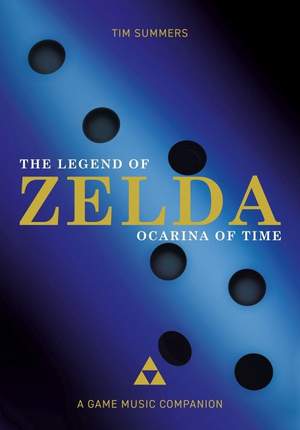Contents
- Chapter 1. Introduction
- Chapter 2. The music of Ocarina of Time in context
- Nintendo's game franchises
- The Legend of Zelda
- Kondo's approach to music in The Legend of Zelda
- Music on the Nintendo 64
- Music in Ocarina of Time
- Chapter 3. The ocarina and Link's musical performances
- The ocarina
- Why an ocarina?
- Playing Link's ocarina
- Beyond the four notes
- Learning the ocarina songs
- The songs
- Plot-advancing and assistance melodies
- Warp songs
- The Scarecrow's song and other performances
- The Fabulous Five froggish tenors
- The Skull Kids
- Musical performance in Ocarina of Time
- The function of musical performance in games
- Chapter 4. Location cues
- Part I. Hyrule Field
- A familiar tune
- Introduction
- Day tags
- Reflective tags
- Battle tags
- Music, the player and geography
- Part II. Location cues featuring ocarina songs
- Epona's song and Lon Lon Ranch - Associations of ranch life
- The Temple of Time and the Song of Time - Cathedral soundscape
- Windmill and the Song of Storms - Strange circularity
- Saria's song and the Lost Woods - Jolly repetition and misdirection
- Part III. Dungeon cues
- Inside the Deku Tree - Organic timbres
- Dodongo's Cavern - Audio textures of metal and stone
- Inside Jabu-Jabu's belly - Fishy rumblings
- Forest Temple - Sounds of the forest
- Fire Temple - Voices heard and unheard
- Ice Cavern - Crystalline chimes
- Water Temple - A dungeon on the Danube?
- Shadow Temple and the bottom of the well - Voices and drums from the depths
- Spirit Temple
- Ganon's Castle
- Part IV. Towns
- Kokiri Forest - Optimism and ornamentation
- Castle Town market - Evoking European traditions
- Kakariko Village - A wistful safe haven
- Goron City - Sounding the materials of the mountain
- Zora's domain
- Gerudo Valley - Hispanic traditions in the desert
- Part V. Recurring types of location
- Shops - Hyrule's consumer soundtrack
- Sideshow minigames - The fairground connection
- Houses - A musical starting point
- Potion shops, ghost shops and lakeside laboratory - Little shops of horrors?
- Fairy Fountain/start menu - Angelic harps
- Music for locations
- Chapter 5. Character themes and cutscenes
- Part I. Character themes
- Zelda's theme - Lilting lullaby
- Ganondorf's theme - Alarming chords and brooding sequences
- Sheik - Atypical warrior's theme
- Kaepora Gaebora (the great wise owl) - Authority and levity
- Great Deku Tree - Ancient uncertainty
- Koume and Kotake
- A noticeable omission
- Part II. Other cutscenes
- Opening - An unexpected start
- Flying - Musical sequences for beating wings
- Legends, spirits and goddesses
- Rewards and milestones
- End credits - Finale ultimo
- Ocarina of Time 3D
- Music for cutscenes
- Chapter 6. Ludic cues
- Part I. Combat music
- Musical features of combat cues
- Implementation in the game
- Boss victory cue
- Part II. Cues for treasure and challenges
- Acquisition cues
- Music for puzzles
- Music for losing - Game over
- Minigames - Frivolous fun
- Special sequences
- Aestheticizing the Ludic
- Chapter 7: Interfaces and sound effects
- Earcons for interfaces
- Menus and dialogue
- Targeting system
- Musical sound for interfaces and information
- Musicality and magic
- Sound and motion
- Enemy sound effects
- Conclusions
- Chapter 8. Ocarina afterlives
- Later games
- Parallel world - Majora's mask
- Selective franchise continuity
- Decontextualizing sound
- A multi-valent musical medium



